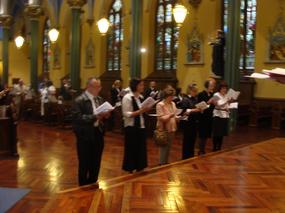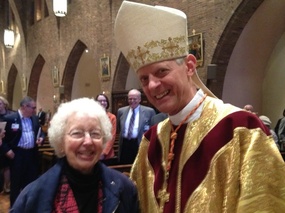other, but also to make ourselves as lovable as possible so that it is easy for
others to love us.”
 One of the US’s monasteries of Benedictine nuns is getting a lot media attention lately. Regina Laudis Abbey (Bethlehem, CT) is now recognized by the European Catholic press for a story written by Mauro Pianta for the Vatican Insider, “U.S.: Cameron’s former lover becomes cloistered nun.” Mr. Pianta tells of the UK’s Prime Minister David Cameron’s former very beautiful girlfriend who found her vocation in the American abbey after a conversion in her life. Sister John Mary known in history as Laura Adshead left the world to follow Christ. Let’s note, however, Sister John Mary has been at the Abbey for four years, now. So this story is not exactly new, but it is good to know that smart women still follow the Lord’s call.
One of the US’s monasteries of Benedictine nuns is getting a lot media attention lately. Regina Laudis Abbey (Bethlehem, CT) is now recognized by the European Catholic press for a story written by Mauro Pianta for the Vatican Insider, “U.S.: Cameron’s former lover becomes cloistered nun.” Mr. Pianta tells of the UK’s Prime Minister David Cameron’s former very beautiful girlfriend who found her vocation in the American abbey after a conversion in her life. Sister John Mary known in history as Laura Adshead left the world to follow Christ. Let’s note, however, Sister John Mary has been at the Abbey for four years, now. So this story is not exactly new, but it is good to know that smart women still follow the Lord’s call.
Saint John’s gospel uses the agricultural image of vine and a vine dresser to express a relationship that is unique. Quite singular when you think that neither the Jews nor the Muslims would admit in terms of intimacy between the Creator and creature, Father and Son, God and me. So, why is Christ called the ‘true vine‘ and why are we his ‘branches’? The short answer is because it is our Christian belief, our Christology, that God is waiting for humanity to bear fruit, sin notwithstanding. The Incarnation, and the proclamation of the Good News tells us of the wine of love, obedience and prayer with the goal of uniting God and humanity in a truer way.
That we are expected to “bear much fruit”
and to rely on the Lord for all things there is a hope that we
remain in Him and that His “words remain in you“. There is a dependence on God in a radical manner that is unheard of in most of relationships. To remain, to abide, to stay close to Jesus is the key of the spiritual life. Not to remain in Christ is reject the offer of Grace. The question of what it means to remain in Christ is given by the second reading: keep the commandments, of both Testaments of sacred Scripture and the teaching of the Church. Concretely, we are nourished by Christ Himself in the sacraments of the Church, notably in the Holy Eucharist.
Continue reading Portsmouth Abbey monks dedicate Lourdes Grotto
 Many of the religious orders have what is called a Third Order Laity, or some such name for the laity who are closely connected spiritually and morally to an Order and continue to live their lives according to the vocation they’ve been given: the single life, married life or secular priesthood.
Many of the religious orders have what is called a Third Order Laity, or some such name for the laity who are closely connected spiritually and morally to an Order and continue to live their lives according to the vocation they’ve been given: the single life, married life or secular priesthood.
 As I mentioned on Monday, we celebrated the feast of Saint Catherine of Siena at the New York City parish under her patronage with a solemn Mass offered by His Eminence, Donald Cardinal Wuerl, STD, archbishop of Washington. The Saint Catherine of Siena Award was bestowed on the Cardinal honoring him for his lifetime work for Catholic health care as was Sister Elaine Goodell, PBVM, for her 27 years as a Catholic chaplain at Memorial Sloan-Kettering Hospital. It is noteworthy that Sister Elaine began her ministry as a hospital chaplain at the age of 60 following a sabbatical from teaching music. This liturgical and professional observance was the Sixth Annual ceremony established by the Dominican Friars Healthcare Ministry of New York.
As I mentioned on Monday, we celebrated the feast of Saint Catherine of Siena at the New York City parish under her patronage with a solemn Mass offered by His Eminence, Donald Cardinal Wuerl, STD, archbishop of Washington. The Saint Catherine of Siena Award was bestowed on the Cardinal honoring him for his lifetime work for Catholic health care as was Sister Elaine Goodell, PBVM, for her 27 years as a Catholic chaplain at Memorial Sloan-Kettering Hospital. It is noteworthy that Sister Elaine began her ministry as a hospital chaplain at the age of 60 following a sabbatical from teaching music. This liturgical and professional observance was the Sixth Annual ceremony established by the Dominican Friars Healthcare Ministry of New York.
In these days following the feast of Saint Catherine of Siena, I thought I would post this rather beautiful extract from one of the saint’s Dialogues. It shows the depth of love that Catherine knew she had with her Savior, her lover.
“O eternal, infinite Good! O mad lover! And you have need of your creature? It seems so to me, for you act as if you could not live without her, in spite of the fact that you are Life itself, and everything has life from you and nothing can have life without you. Why then are you so mad? Because you have fallen in love with what you have made! You are pleased and delighted over her within yourself, as if you were drunk with desire for her salvation. She runs away from you and you go looking for her. She strays and you draw closer to her. You clothed yourself in our humanity, and nearer than that you could not have come.”
Catherine of Siena, The Dialogue, tr. Suzanne Noffke (New York: Paulist Press 1980) 325.
We join with the Pope, Benedict XVI, in prayer before the Divine Majesty for the following intentions:
The general intention
That initiatives which defend and uphold the role of the family may be promoted within society.
The missionary intention
That Mary, Queen of the World and Star of Evangelization, may accompany all missionaries in proclaiming her Son Jesus.
Work is often treated as a four letter word; something to be avoided. Understanding what the value of work is today is rather complex due to the ideology we’ve been subjected to since at least the 19th century as a result of industrialism, Communism and Socialism.
One of the many beautiful things John Paul II wrote about is the human person and how the person is meant to thrive, not just exist. His ideas about what and who the person is understood in what he taught about subjectivity, meaning that there is “the ground on which the dynamic relation, or rather inter-relation, between the person and the action is actualized. The failure to recognize man´s subjectivity would deprive us of the level on which can be grasped all the aspects of this interrelation.”
Continue reading Saint Joseph the Work: the model of holiness through working